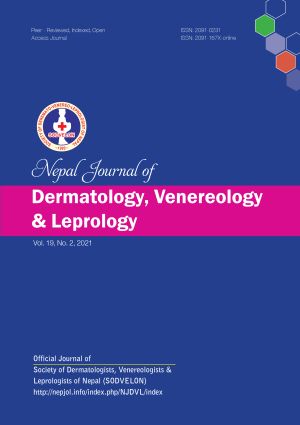Melatonin - A Cutaneous Perspective
DOI:
https://doi.org/10.3126/njdvl.v19i2.39452Keywords:
Antioxidant, Melatonin, Photoprotection, SkinAbstract
Melatonin (MLT) is an endogenous hormone secreted from the pineal gland, located deep in the brain in the epithalamus associated with numerous biological activities. The primary function of melatonin is to regulate sleep-wake cycles. However, research over the last few years has enlightened a range of functions associated with this molecule, including anti-inflammatory, direct and indirect antioxidant activity, regenerative tissue benefits, and preservation of mitochondrial function. Melatonin’s anti-inflammatory and antioxidant support, coupled with its mitochondrial modulation, makes it a vital molecule to use for skin health homeostasis. The cutaneous melatoninergic system’s widespread expression and pleiotropic activity provides for a high level of cell-specific selectivity. Several skin cells, including normal and malignant keratinocytes, melanocytes, fibroblasts and hair follicles, express melatonin receptors. Melatonin also has receptor-independent effects that protect against oxidative stress and can reduce ultraviolet radiation-induced damage. Several functions of melatonin in the skin have been experimentally implicated such as hair growth cycling, fur pigmentation, melanoma control, suppression of ultraviolet-induced damage to the skin cell. Melatonin may play a role in treating several dermatoses e.g., atopic eczema, psoriasis, melasma, ulcer healing, and malignant melanoma. There is a plethora of functional melatonin properties, which still await to be fully appreciated by dermatologists. The current review emphasizes few of the established uses and few emerging potentialities that render melatonin a promising candidate for managing several diseases.
Downloads
Downloads
Published
How to Cite
Issue
Section
License
Copyright (c) 2021 Society of Dermatologists, Venereologists and Leprologists of Nepal

This work is licensed under a Creative Commons Attribution 4.0 International License.
Copyright on any research article is transferred in full to Nepal Journal of Dermatology, Venereology & Leprology upon publication. The copyright transfer includes the right to reproduce and distribute the article in any form of reproduction (printing, electronic media or any other form).




